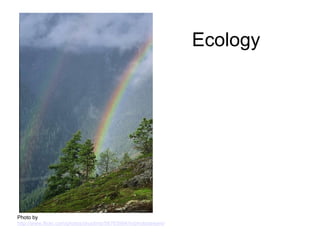Copy of ecology
•Télécharger en tant que PPT, PDF•
1 j'aime•227 vues
Signaler
Partager
Signaler
Partager

Recommandé
Recommandé
Contenu connexe
Tendances (19)
En vedette
En vedette (8)
Restaurants & Mobile - Why Your Restaurant Needs A Mobile Experience

Restaurants & Mobile - Why Your Restaurant Needs A Mobile Experience
Similaire à Copy of ecology
Similaire à Copy of ecology (20)
EVS Notes- Ecosystem, Biotic, Abiotic, Ecological succession

EVS Notes- Ecosystem, Biotic, Abiotic, Ecological succession
Dernier
Dernier (20)
Intro to Passkeys and the State of Passwordless.pptx

Intro to Passkeys and the State of Passwordless.pptx
Collecting & Temporal Analysis of Behavioral Web Data - Tales From The Inside

Collecting & Temporal Analysis of Behavioral Web Data - Tales From The Inside
Long journey of Ruby Standard library at RubyKaigi 2024

Long journey of Ruby Standard library at RubyKaigi 2024
Event-Driven Architecture Masterclass: Engineering a Robust, High-performance...

Event-Driven Architecture Masterclass: Engineering a Robust, High-performance...
Harnessing Passkeys in the Battle Against AI-Powered Cyber Threats.pptx

Harnessing Passkeys in the Battle Against AI-Powered Cyber Threats.pptx
Your enemies use GenAI too - staying ahead of fraud with Neo4j

Your enemies use GenAI too - staying ahead of fraud with Neo4j
Continuing Bonds Through AI: A Hermeneutic Reflection on Thanabots

Continuing Bonds Through AI: A Hermeneutic Reflection on Thanabots
Introduction to FIDO Authentication and Passkeys.pptx

Introduction to FIDO Authentication and Passkeys.pptx
Extensible Python: Robustness through Addition - PyCon 2024

Extensible Python: Robustness through Addition - PyCon 2024
Human Expert Website Manual WCAG 2.0 2.1 2.2 Audit - Digital Accessibility Au...

Human Expert Website Manual WCAG 2.0 2.1 2.2 Audit - Digital Accessibility Au...
State of the Smart Building Startup Landscape 2024!

State of the Smart Building Startup Landscape 2024!
(Explainable) Data-Centric AI: what are you explaininhg, and to whom?

(Explainable) Data-Centric AI: what are you explaininhg, and to whom?
Breaking Down the Flutterwave Scandal What You Need to Know.pdf

Breaking Down the Flutterwave Scandal What You Need to Know.pdf
FDO for Camera, Sensor and Networking Device – Commercial Solutions from VinC...

FDO for Camera, Sensor and Networking Device – Commercial Solutions from VinC...
Choosing the Right FDO Deployment Model for Your Application _ Geoffrey at In...

Choosing the Right FDO Deployment Model for Your Application _ Geoffrey at In...
Secure Zero Touch enabled Edge compute with Dell NativeEdge via FDO _ Brad at...

Secure Zero Touch enabled Edge compute with Dell NativeEdge via FDO _ Brad at...
Copy of ecology
- 1. Ecology Photo by http://www.flickr.com/photos/druclimb/56763994/in/photostream/
- 2. ECOLOGY - the study of interactions among organisms with each other and with environment BIOSPHERE - portion of planet where life exists
- 3. LEVELS OF ORGANIZATION Species - individuals that can breed with one another Population - all the individuals of the same species (butterflies) in an area
- 4. A population is always composed of same-species organisms
- 5. Community - all the populations that live together in an area
- 6. What is in your backyard community?
- 7. Ecosystem - the community plus the physical factors in an area (rain, light, soil..) Examples: Rotting Log Koi Pond Lake Clump of Dirt A field An old maple tree
- 8. Biome - large area that has a particular climate, and particular species of plants and animals that live there (tundra)
- 9. Biosphere - the part of the earth that supports life
- 10. Ecological methods - how do we study it? Observing Experimenting Modeling Models are created by humans to make predictions.
- 11. Sometimes, you must be cautious in how a model interprets data.... Imagine graphing a person's height as they age. One could predict that by the time they were age 30, they would be 22 feet tall. However, the model would need to account for the slowing of growth after adolescence.
- 13. 3-2 Energy Flow Autotrophs (producers) - capture energy from environment and convert it into "food" Heterotrophs (consumers) - must eat things Herbivores Carnivores Omnivores Detritivores / Decomposers
- 14. *SUNLIGHT is the main source of energy* Photosynthesis - uses light energy to make "food"
- 15. Chemosynthesis - makes food from chemicals (some bacteria synthesize food in this way) Some bacteria live in deep ocean vents, and make their food from chemicals in those vents
- 16. FOOD CHAINS AND FOOD WEBS - illustrate the flow of energy in an ecosystem *Note the direction of the arrows, they indicate where the energy is going when one organism consumes another . Each step in a chain or web is called a TROPHIC LEVEL
- 17. Identify: Primary Consumers Secondary Consumers Tertiary Consumers Find the Omnivore.
- 18. Ecological Pyramids (fig 3-9) Energy Pyramid Biomass Pyramid Pyramid of Numbers
- 19. 3.3 Biogeochemical Cycles (biology + geology + chemical) Matter is not used up, it is transformed, the same molecules are passed around (see images in your book) Graphics Carbon Cycle Water Cycle Nitrogen Cycle Water Cycle ground water transpiration (from plants) evaporation (from bodies of water) precipitation (from clouds)
